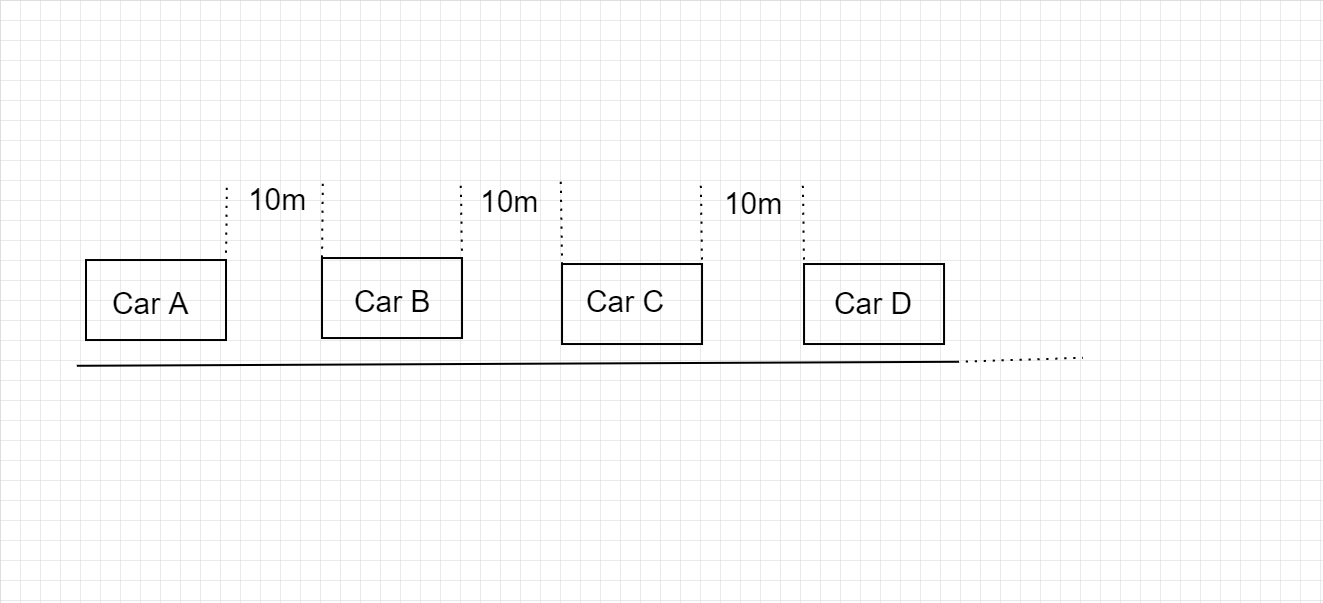
Answer
359.7k+ views
Hint:First defined average velocity formula. Taking the given value and putting the second equation of motion will give the time interval for one car multiple with total car moving. Further distance covered by one car is multiplied by the total car in-between distance. After, the formula for finding the average rate of change in length of the segment.
Complete step-by-step solution:
Uniform motion:
An object can be termed as uniform motion if it covers equal distance in equal time intervals, however small these time intervals may be in the same fixed direction.
Average velocity:
For an object moving with not consistent velocity, average velocity is defined as the ratio of its total displacement to the total time interval in which that displacement occurs.
If \[{{s}_{1}}\] and \[{{s}_{2}}\] are the positions for an object at times \[{{t}_{1}}\] and\[{{t}_{2}}\], then the average velocity from time \[{{t}_{2}}\] and \[{{t}_{1}}\] is given by
\[{{v}_{av}}=\dfrac{{{s}_{2}}-{{s}_{1}}}{{{t}_{2}}-{{t}_{1}}}\]
At the start of convey one
Acceleration is given \[2\dfrac{m}{{{s}^{2}}}\]
The following car starts moving after the preceding car reaches a distance of \[35m\].
Time is taken to reach\[35m\], t have to be found
Equation of motion for the uniformly accelerated motion:
\[s=ut+\dfrac{1}{2}a{{t}^{2}}\]
Time is taken to reach\[35m\], t have to be found
\[35=\left( 0 \right)t+\dfrac{1}{2}\times 2{{t}^{2}}\]
\[{{t}^{2}}=35\]
\[t\simeq 6\sec \]
Each car start moving after \[6\] seconds
Initially, the length of the segments having stationary cars can be calculated by the space given between cars that will be \[49\]spaces and the distance between them is\[10m\].
Total \[50\] cars then, \[49\]spaces between them:
\[49\times 10=490\]
Thus, the distance becomes\[490m\].
After \[6\sec \]one car starts moving, which means the length of the segment between stationary cars decreases by \[10m\] after each\[6\sec \].
As there are \[50\] cars and the \[{{49}^{th}}\]car starts moving the distance between the stationary cars becomes\[0\].
It takes about \[49\times 6\]seconds for this
The Formula for Average acceleration:
\[{{v}_{av}}=\dfrac{{{s}_{2}}-{{s}_{1}}}{{{t}_{2}}-{{t}_{1}}}\]
\[=\dfrac{\Delta s}{\Delta t}\]
Where\[\Delta s\] is the distance and \[\Delta t\] is the average time
\[=\dfrac{490}{49\times 6}\]
\[=\dfrac{10}{6}\]
\[\simeq 2\dfrac{m}{s}\]
As the distance is decreasing with the car moving to the preceding car position, the Average rate of change of length of the segment will be decreasing too.
Thus, the final result is decreasing at\[2\dfrac{m}{s}\]
Note:The average velocity is always less than or equal to the average speed of an object. This can be seen by realizing that while distance is always strictly increasing, displacement can increase or decrease in magnitude as well as change direction. The average speed is a scalar quantity and not a vector quantity.
Complete step-by-step solution:
Uniform motion:
An object can be termed as uniform motion if it covers equal distance in equal time intervals, however small these time intervals may be in the same fixed direction.
Average velocity:
For an object moving with not consistent velocity, average velocity is defined as the ratio of its total displacement to the total time interval in which that displacement occurs.
If \[{{s}_{1}}\] and \[{{s}_{2}}\] are the positions for an object at times \[{{t}_{1}}\] and\[{{t}_{2}}\], then the average velocity from time \[{{t}_{2}}\] and \[{{t}_{1}}\] is given by
\[{{v}_{av}}=\dfrac{{{s}_{2}}-{{s}_{1}}}{{{t}_{2}}-{{t}_{1}}}\]
At the start of convey one
Acceleration is given \[2\dfrac{m}{{{s}^{2}}}\]
The following car starts moving after the preceding car reaches a distance of \[35m\].
Time is taken to reach\[35m\], t have to be found
Equation of motion for the uniformly accelerated motion:
\[s=ut+\dfrac{1}{2}a{{t}^{2}}\]
Time is taken to reach\[35m\], t have to be found
\[35=\left( 0 \right)t+\dfrac{1}{2}\times 2{{t}^{2}}\]
\[{{t}^{2}}=35\]
\[t\simeq 6\sec \]
Each car start moving after \[6\] seconds
Initially, the length of the segments having stationary cars can be calculated by the space given between cars that will be \[49\]spaces and the distance between them is\[10m\].
Total \[50\] cars then, \[49\]spaces between them:
\[49\times 10=490\]
Thus, the distance becomes\[490m\].
After \[6\sec \]one car starts moving, which means the length of the segment between stationary cars decreases by \[10m\] after each\[6\sec \].
As there are \[50\] cars and the \[{{49}^{th}}\]car starts moving the distance between the stationary cars becomes\[0\].
It takes about \[49\times 6\]seconds for this
The Formula for Average acceleration:
\[{{v}_{av}}=\dfrac{{{s}_{2}}-{{s}_{1}}}{{{t}_{2}}-{{t}_{1}}}\]
\[=\dfrac{\Delta s}{\Delta t}\]
Where\[\Delta s\] is the distance and \[\Delta t\] is the average time
\[=\dfrac{490}{49\times 6}\]
\[=\dfrac{10}{6}\]
\[\simeq 2\dfrac{m}{s}\]
As the distance is decreasing with the car moving to the preceding car position, the Average rate of change of length of the segment will be decreasing too.
Thus, the final result is decreasing at\[2\dfrac{m}{s}\]
Note:The average velocity is always less than or equal to the average speed of an object. This can be seen by realizing that while distance is always strictly increasing, displacement can increase or decrease in magnitude as well as change direction. The average speed is a scalar quantity and not a vector quantity.
Recently Updated Pages
How many sigma and pi bonds are present in HCequiv class 11 chemistry CBSE

Mark and label the given geoinformation on the outline class 11 social science CBSE

When people say No pun intended what does that mea class 8 english CBSE

Name the states which share their boundary with Indias class 9 social science CBSE

Give an account of the Northern Plains of India class 9 social science CBSE

Change the following sentences into negative and interrogative class 10 english CBSE

Trending doubts
Difference Between Plant Cell and Animal Cell

Difference between Prokaryotic cell and Eukaryotic class 11 biology CBSE

Fill the blanks with the suitable prepositions 1 The class 9 english CBSE

Differentiate between homogeneous and heterogeneous class 12 chemistry CBSE

Which are the Top 10 Largest Countries of the World?

One cusec is equal to how many liters class 8 maths CBSE

Give 10 examples for herbs , shrubs , climbers , creepers

The mountain range which stretches from Gujarat in class 10 social science CBSE

The Equation xxx + 2 is Satisfied when x is Equal to Class 10 Maths




